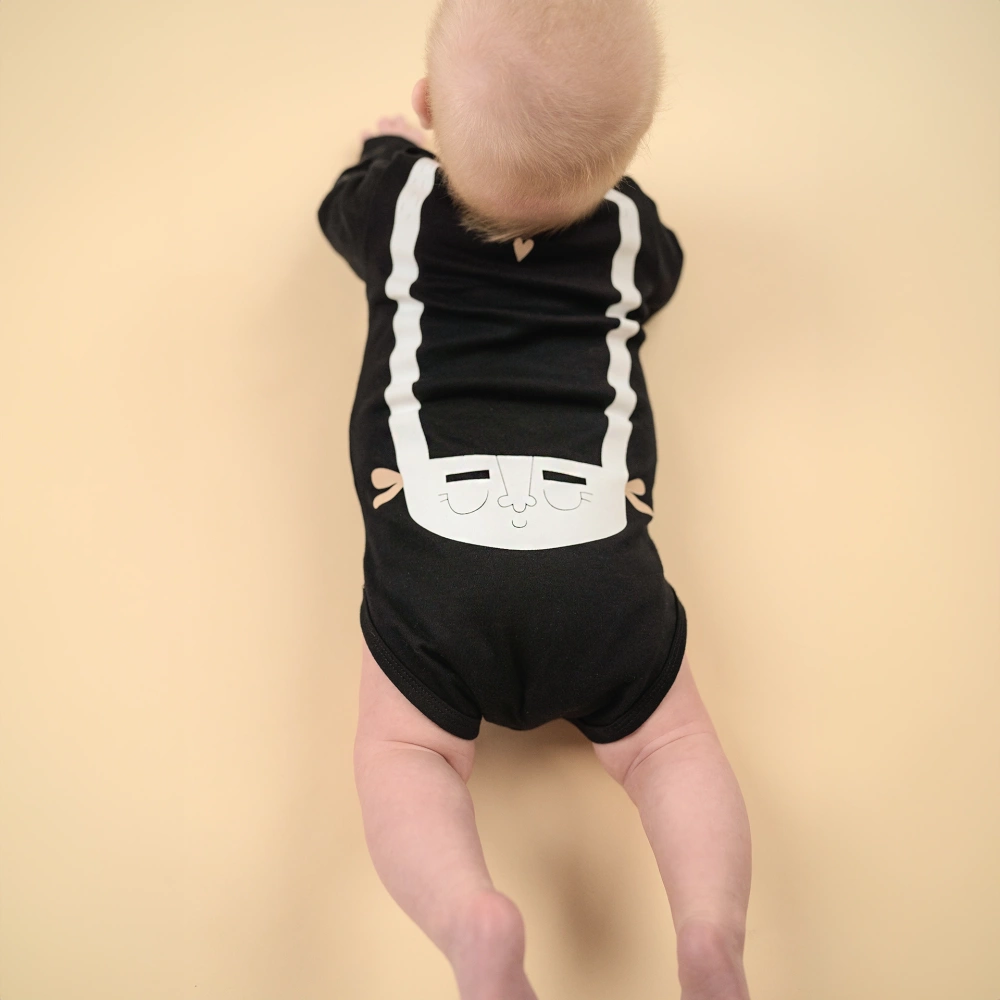Tummas
- Long-sleeved bodysuit


The Tummas bodysuit motivates parents to lay their baby on their belly so that the little one experiences their body and explores it in different positions in space.
The journey to discovering the big world starts with lying on the tummy and getting out of the bent-over position. This trains the shoulder, nape, and neck muscles. Lying down, babies begin to prop themselves up, stretching their curious arms out in front of them, and shifting their weight backwards, which further helps them in controlling their heads in space.
Tummas encourages parents to place their baby in the best possible position, which is on the tummy. Long ears routed across the back guard the correct positioning of the toddler and signal any potential positional asymmetry. In addition, the non-slip prints on the forearms help babies to support themselves. Make sure your little one lays on a firm and stable surface.
We have created our long-sleeved bodysuit from soft cotton knitted fabric designed by Magdalena with original prints by the illustrator Karolina. The nickel-free press studs on both sides make it easy to put the garment on and also encourage symmetrical nursing, extremely important in your baby’s development.

physiotherapist
Justyna Miller*friends call her Isia
Why is laying a baby on their tummy so important?
New parents are often afraid to place their newborns on their tummies. Don’t be! It is the starting position from which the baby can observe the world and experience the positioning of his or her body in space, and is therefore essential for the development of the baby’s subsequent skills.
Imagine lying in bed all day. What do you see? The ceiling, the light... and again the ceiling. When babies are lying on their back, their field of vision is greatly limited. In addition, newborns do not see clearly yet. They follow the light with their eyes, often bending over to see it. They cannot yet turn on their own, so it is up to you to ensure a position on their tummy that provides a more favourable environment for them to explore the world and motivates them to move around.
What is the deal with straightening up?
Let’s keep in mind that the newborn baby’s body has been „packed” for nine months so that when it comes into the world, it can „unpack”. Babies are born with their arms and legs bent, and their spine is in full kyphosis, i.e. bent into a letter C. The position on the tummy is therefore irreplaceable as it gives babies the opportunity to progressively straighten their limbs and spines.
From birth, babies develop in their bodies the straightening reaction, that is the reaction of the body, head and limbs against the force of gravity. The belly position helps to accomplish control of the head in space, which is a key skill for sustaining an upright position in the future.
In order to work the flexors and extensors evenly, the baby should be in both the back and tummy positions for the same amount of time during the day. This will ensure a well-rounded experience for the toddler.
Hard or soft surface?
When placing your baby on the floor, provide a stable surface. This allows toddlers to use their arms to push off and lift their heads.
Do not put your baby on:
- a mattress – an unstable surface requires babies to concentrate on
keeping their balance instead of making it easier for them to play freely
- a slippery plush blanket – in this instance you will also be making it more
difficult for them, as they will not have enough friction to generate force
from the ground.
Placental asymmetry?
Placement asymmetry can be due to the positioning of the baby in the womb. It usually disappears when symmetrical care is performed.
The use of Tummas? Tips from the physiotherapist :)
When babies are lying on their tummies, it is useful to observe how their bodies are positioned. Tummas will make it easier to assess whether the baby is lying symmetrically, or whether he or she is shortening either side. In the first weeks of life, babies make various movements that can place their bodies in asymmetrical positions. Do not worry about this! This is a natural process in which the reflexes integrate so that the higher centres in the brain can perform a variety of functions. It is worth checking if the baby turns his or her head from side to side when lying on the tummy. This is where Tummas comes in handy to show if the baby turns either side excessively. Around 3 months of age the baby achieves symmetry of the head and body – observe if lying on their tummy they support themselves symmetrically on their forearms.
However, if you observe worsening of the positional asymmetry in your baby, see your doctor. It may be necessary to carry out more extensive diagnostics or to implement rehabilitation.

Fabrics
At Say Mommy, we prioritise high quality materials.
Fabric composition: 100% cotton
Oeko-Tex® Certificate
Maintenance
Caring for the Shapies equals caring for the environment. We encourage you to follow the maintenance instructions below.
We recommend:
- Wash on the left side. The black colour is sealed.
- First wash: Launder the garment separately according to the washing instruction.
- Subsequent washes: Launder black garments with dark colours according to the washing instructions.
- Do not iron over prints, alternatively iron on the left side.
- Machine wash at max. 40 degrees.
- Do not bleach.
- Do not dry clean.
- Iron at max. 150 degrees.
- Do not tumble dry.
The entire collection was designed and produced in Poland.




















